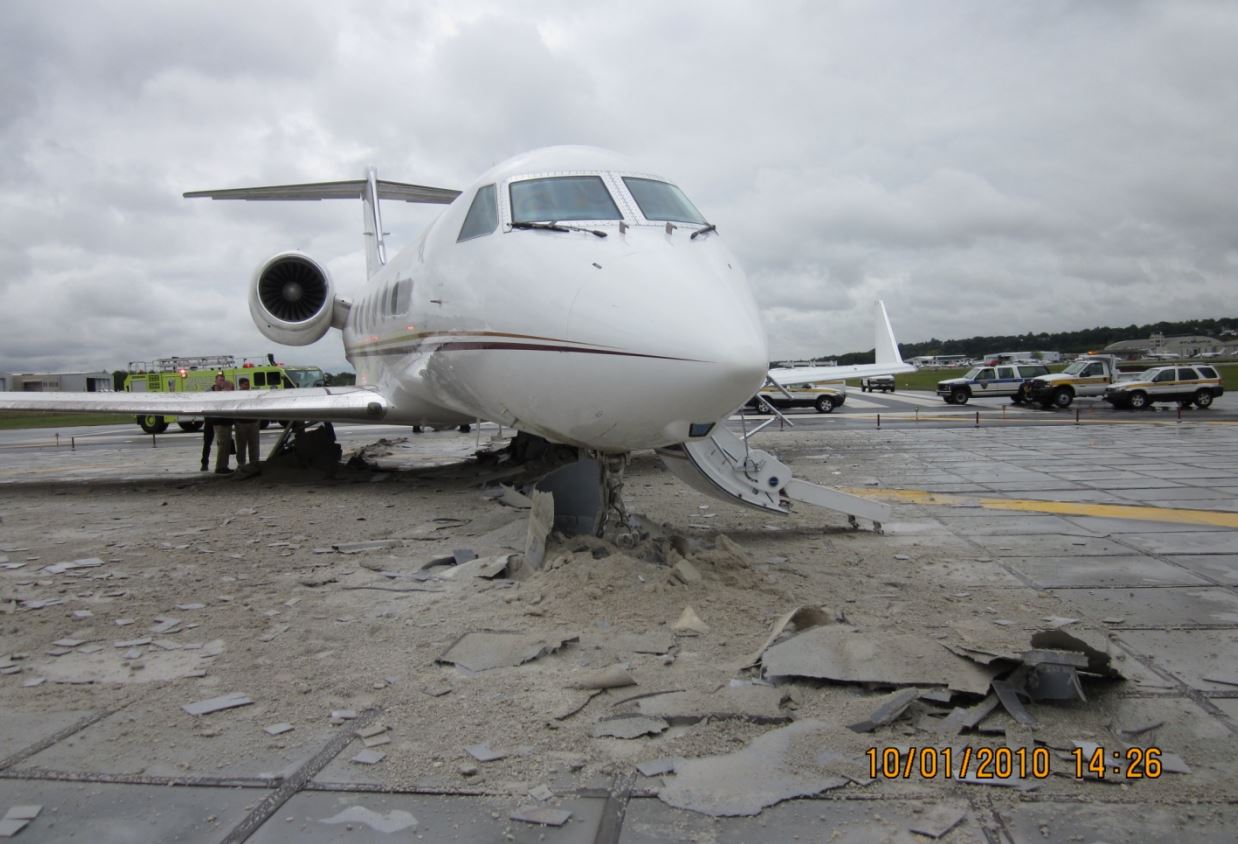
ASN Wikibase Occurrence # 219110
This information is added by users of ASN. Neither ASN nor the Flight Safety Foundation are responsible for the completeness or correctness of this information.
If you feel this information is incomplete or incorrect, you can submit corrected information.
| Date: | Friday 1 October 2010 |
| Time: | 13:37 |
| Type: |  Gulfstream G-IV |
| Owner/operator: | Avenue Capital Management II |
| Registration: | N923CL |
| MSN: | 1471 |
| Year of manufacture: | 2002 |
| Engine model: | Rolls Royce TAY 611SER |
| Fatalities: | Fatalities: 0 / Occupants: 10 |
| Aircraft damage: | Minor |
| Category: | Incident |
| Location: | Teterboro Airport, NJ (TEB/KTEB) -
 United States of America United States of America
|
| Phase: | Landing |
| Nature: | Executive |
| Departure airport: | Toronto-Pearson International Airport, ON (YYZ/CYYZ) |
| Teterboro Airport, NJ (TEB/KTEB) | |
| Investigating agency: | NTSB |
| Confidence Rating: |
On October 1, 2010, at 1337 eastern daylight time, a Gulfstream Aerospace G-IV, N923CL, operated by Avenue Capital Management II and managed by General Aviation Flying Service Inc., d.b.a Meridian Air Charter Inc, incurred minor damage during a landing overrun on runway 6 at Teterboro Airport (TEB), New Jersey. The two pilots, one flight attendant, and seven passengers were not injured.
According to written statements, the pilot-in-command (PIC) was the pilot flying and the copilot was the pilot monitoring. As the flight approached TEB, the pilots received the current automated terminal information system (ATIS) data, which indicated the winds were from 360 degrees at 6 knots, gusting to 15 knots. The pilots programmed the flight management system with the current winds and temperature, which provided a reference speed (ref) of 136 knots.
The approach was briefed and the pilots elected to add 10 knots to the ref speed due to the wind conditions. The flight descended on a localizer approach for runway 6, a 6,013 foot long, 150-foot-wide, grooved asphalt runway. While descending through 700 feet mean sea level (msl), the copilot obtained a wind check from the control tower, which indicated the winds were from 010 degrees at 15 knots, gusting to 25 knots. About 500 feet msl, the flight experienced some buffeting and slowed to 136 knots. The autothrottles were then deactivated by the PIC and he manually controlled the throttles while the airspeed varied between ref plus 5 knots and ref plus 15 knots.
The PIC further stated that, in the landing flare, the copilot announced the speed was ref plus 10 knots, and the PIC reduced the throttles to idle power. At ref speed, just prior to touchdown, a gust of wind caused the airplane to "float up" approximately 15 feet above the ground, before descending back down to the runway. The PIC further stated that at no point did either pilot believe there was not adequate runway remaining to continue the landing. The airplane touched down at 120 knots and the copilot stated that a crew advisory system (CAS) message generated for ground spoiler deployment. Thrust reversers then deployed and braking began immediately, with activation of the anti-skid system. At that point the airplane was decelerating through 80 knots and the pilots still felt the airplane would stop on the remaining runway; however, the airplane departed the end of the runway at 40 to 50 knots. The airplane traveled about 100 feet into an engineered materials arresting system (EMAS), located immediately beyond the runway, and came to rest.
Probable Cause and Findings:
The National Transportation Safety Board determines the probable cause(s) of this incident to be:
The pilot-in-command's failure to attain the proper touchdown point while landing with a gusting crosswind and failure to initiate a go-around, which resulted in a landing more than halfway down the runway and a subsequent runway overrun. Contributing to the incident was the failure of either pilot to call for a go-around when the airplane was at Vref plus 15 at 50 feet above the runway or once they had floated well beyond the touchdown zone of the runway.
Accident investigation:
 |
|
Sources:
NTSB
Location
Images:

Photo: FAA
Revision history:
| Date/time | Contributor | Updates |
|---|---|---|
| 06-Dec-2018 20:46 | harro | Added |
| 16-Dec-2018 18:39 | harro | Updated [Photo] |
Corrections or additions? ... Edit this accident description
The Aviation Safety Network is an exclusive service provided by:


 ©2024 Flight Safety Foundation
©2024 Flight Safety Foundation